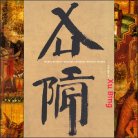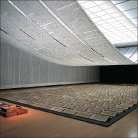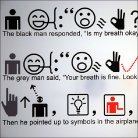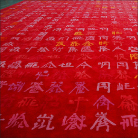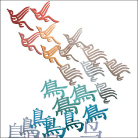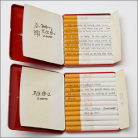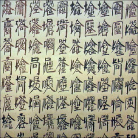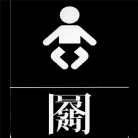XU BING RETROSPECTIVE
Xu is most famous for his special focus on and manipulation of language and typography. In this retrospective, the museum will bring together and examine the most important works formative and representative of his international career from 1980s to today. Highlights of this retrospective include Book from the Sky and Book from the Ground.
In the late 1980s, Xu invented 4,000 authentic-looking Chinese characters and spent over a year hand-carving them into wood blocks and type. Those hand-printed, unintelligible characters formed Book from the Sky (Tian Shu). Xu’s Book from the Sky was originally created to express his feelings about popular culture at that time. Following Book from the Sky, Xu Bing worked on a completely different project-Book from the Ground (Di Shu)--a book he claims that everybody, regardless of cultural background or educational levels, can read. In Book from the Ground, Xu tried to develop a new kind of communication system relying on universal symbols, such as the icons and logos that people around the world come across every day in places such as airports and bathrooms. Everybody can feel the restraints traditional languages place on modern society, adding that his intention was to create a way of communication using the simplest, most direct and common signs. Xu’s inspiration for the universal signs was drawn from the ancient Chinese form of pictographs. The modern Chinese written language is based on using pictures for words, and the characters have developed over thousands of years. Xu developed his new language using his keen sense of art, which grasped the real essence of common signs from his everyday life and frequent travels.
Book from the Sky showed his dissatisfaction toward the current language system while the Book from the Ground revealed his ideals for a common language applied to people all over the world, he added. With both books, Xu also tried to convey a universal message: Everybody is equal in their approach to the two books, as one is unreadable while the other is understandable to all. Reading them does not depend on the viewer’s culture, social status, ethnicity, or education. From the thorough denial of the value of language to the earnest search for a trans-cultural communication tool, language has always been at the core of Xu’s artistic works.
Xu Bing’s creative manipulation of language has also touched upon English words, a foreign language for him. In the mid-1990s, Xu invented what he calls “Square Word Calligraphy.” He arranged English letters in squares to make the words look like Chinese characters, yet they remain legible to the English speaker.
Xu Bing was born in Chongqing, China in 1955. In 1977 he entered the printmaking department of the Central Academy of Fine Arts, Beijing (CAFA) where completed his bachelor’s degree in 1981 and stayed on as an instructor, earning his MFA in 1987. In 1990, on the invitation of the University of Wisconsin-Madison, he moved to the United States. Xu currently serves as the Vice President of CAFA.

